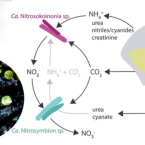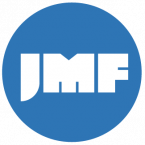Publications
Publications in peer reviewed journals
Co-occurring nitrifying symbiont lineages are vertically inherited and widespread in marine sponges.
2024 - ISME J, in press
Abstract:
Ammonia-oxidising archaea and nitrite-oxidising bacteria are common members of marine sponge microbiomes. They derive energy for carbon fixation and growth from nitrification - the aerobic oxidation of ammonia to nitrite and further to nitrate - and are proposed to play essential roles in the carbon and nitrogen cycling of sponge holobionts. In this study, we characterise two novel nitrifying symbiont lineages, Candidatus Nitrosokoinonia and Candidatus Nitrosymbion in the marine sponge Coscinoderma matthewsi using a combination of molecular tools, in situ visualisation, and physiological rate measurements. Both represent a new genus in the ammonia-oxidising archaeal class Nitrososphaeria and the nitrite-oxidising bacterial order Nitrospirales, respectively. Furthermore, we show that larvae of this viviparous sponge are densely colonised by representatives of Ca. Nitrosokoinonia and Ca. Nitrosymbion indicating vertical transmission. In adults, the representatives of both symbiont genera are located extracellularly in the mesohyl. Comparative metagenome analyses and physiological data suggest that ammonia-oxidising archaeal symbionts of the genus Ca. Nitrosokoinonia strongly rely on endogenously produced nitrogenous compounds (i.e., ammonium, urea, nitriles/cyanides, and creatinine) rather than on exogenous ammonium sources taken up by the sponge. Additionally, the nitrite-oxidising bacterial symbionts of the genus Ca. Nitrosymbion may reciprocally support the ammonia-oxidisers with ammonia via the utilisation of sponge-derived urea and cyanate. Comparative analyses of published environmental 16S rRNA gene amplicon data revealed that Ca. Nitrosokoinonia and Ca. Nitrosymbion are widely distributed and predominantly associated with marine sponges and corals, suggesting a broad relevance of our findings.
Viral potential to modulate microbial methane metabolism varies by habitat.
2024 - Nat Commun, 1: 1857
Abstract:
Methane is a potent greenhouse gas contributing to global warming. Microorganisms largely drive the biogeochemical cycling of methane, yet little is known about viral contributions to methane metabolism (MM). We analyzed 982 publicly available metagenomes from host-associated and environmental habitats containing microbial MM genes, expanding the known MM auxiliary metabolic genes (AMGs) from three to 24, including seven genes exclusive to MM pathways. These AMGs are recovered on 911 viral contigs predicted to infect 14 prokaryotic phyla including Halobacteriota, Methanobacteriota, and Thermoproteota. Of those 24, most were encoded by viruses from rumen (16/24), with substantially fewer by viruses from environmental habitats (0-7/24). To search for additional MM AMGs from an environmental habitat, we generate metagenomes from methane-rich sediments in Vrana Lake, Croatia. Therein, we find diverse viral communities, with most viruses predicted to infect methanogens and methanotrophs and some encoding 13 AMGs that can modulate host metabolisms. However, none of these AMGs directly participate in MM pathways. Together these findings suggest that the extent to which viruses use AMGs to modulate host metabolic processes (e.g., MM) varies depending on the ecological properties of the habitat in which they dwell and is not always predictable by habitat biogeochemical properties.



